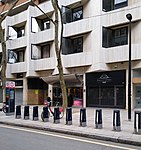Ye Olde Mitre
1773 establishments in Great BritainBuildings and structures in HolbornCommercial buildings completed in 1773Fuller's pubsGrade II listed buildings in the London Borough of Camden ... and 7 more
Grade II listed pubs in LondonLondon building and structure stubsNational Inventory PubsPub stubsPubs in the London Borough of CamdenUnited Kingdom listed building stubsUse British English from March 2014

The Ye Olde Mitre is a Grade II listed public house at 1 Ely Court, Ely Place, Holborn, London EC1N 6SJ.It is on the Campaign for Real Ale's National Inventory of Historic Pub Interiors.Historic England documents indicate that the pub was built about 1773, and remodelled internally in the early 20th century.The pub's website reports the original build year as 1546 with building expansion occurring in 1782, and remodelled in the early 1930s. It is run by Fuller.
Excerpt from the Wikipedia article Ye Olde Mitre (License: CC BY-SA 3.0, Authors, Images).Ye Olde Mitre
Ely Place, London Holborn (London Borough of Camden)
Geographical coordinates (GPS) Address External links Nearby Places Show on map
Geographical coordinates (GPS)
| Latitude | Longitude |
|---|---|
| N 51.518439 ° | E -0.107425 ° |
Address
Ye Olde Mitre
Ely Place 1
EC1N 6SJ London, Holborn (London Borough of Camden)
England, United Kingdom
Open on Google Maps









